Lewis Gun (Machine Gun) Used to Kill Emus in the Great Emu War, 1932
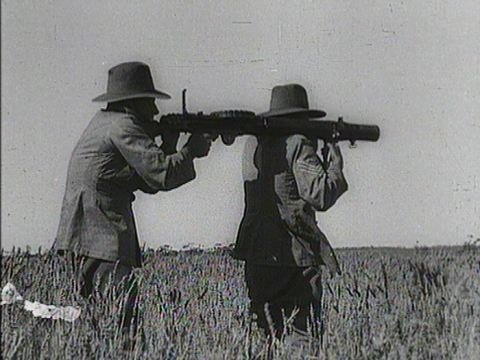
Credit: Author Unknown. Wazee Digital. Public domain.
The emu, a flightless bird in Australia, loved by all. Well, not all. In 1932, the Australian government waged war against the emu. The war lasted for all of two months, and though humans carried machine guns, the emu was the undisputed victor.
An Emu

Credit: Donald Hobern from Copenhagen, Denmark. Used under CC 2.0 license.
I learned about this peculiar chapter in the ongoing saga of man vs nature as I explored the habits of flightless birds. The emu is the second largest bird in the world. That is, the second tallest, though not the second heaviest.That honor goes to the cassowary.
The tallest, and heaviest bird in the world is the ostrich -- also a flightless bird. Ostriches are native to Africa (though some may be found in Australia). The emu is native to Australia, although it was once also found in Tasmania.
Emus laid claim to Australia about 80 million years ago. According to most recently discovered fossil evidence, humans did not arrive on the continent until 20,000 years ago. So, in a sense, humans were squatters on land previously occupied by emus.
However, this argument did not prevail in 1932. That's when a large emu migration conflicted with a significant human migration. The Australian government had settled veterans of WWI on western lands in hopes of developing that territory. These farmers struggled against the elements. They seemed to manage, with difficulty, until a drought drove emus (20,000 of them!) to migrate in unusually large numbers from coastal grazing grounds.
To complicate matters, Australia, and the entire world, was plunged in the Great Depression. Economic survival, everywhere, was a challenge.
Damage Caused by Emus, 1932 Western Australia
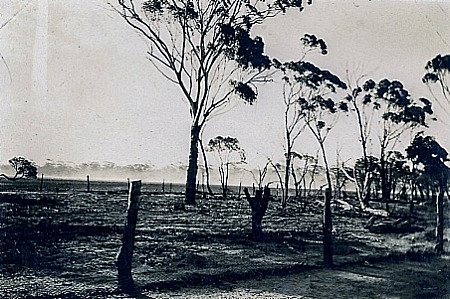
Author unknown. Source Pickering Brook Heritage. Public domain
Emus eat plants, seeds and insects. They are not discriminating in their diet and will eat just about any kind of vegetation. Hence the difficulty with farmers.
Migrating emus ate crops. Not only did the emus consume crops, but in pursuit of food, they trampled what they did not eat. They tore holes in fences and thus allowed other 'pests', such as rabbits, to invade farms. It happened that at the same time, farmers were also fighting off a rabbit invasion.
The Emu
This tallest bird of Australia is also its national bird. It is a member of the Ratite family, a family of flightless birds. The existence of flightless birds fascinates me. It would seem that their chances of survival should be minimal, because of the difficulty in eluding predators. However, nature accommodates.
Traditionally, it was believed that the existence of flightless birds could be traced to the time, millions of years ago, when the continents separated.
Supercontinent Gondwana, 420 Millions Years Ago. Focal Point, South Pole

Credit Fama Clamosa. Used under Creative Commons Attribution-Share Alike 4.0 International, 3.0 Unported, 2.5 Generic, 2.0 Generic and 1.0 Generic license. As @eniolw clarifies in the comment section (below this blog), "Gondwana ('s)... breakup started about 180 million years ago and birds probably appeared after that". Or at least, that's the most likely theory :)
It seems, however, from DNA evidence, that most flightless birds actually flew once, or at least their ancestors did. It is believed that the ancestors arrived by flight long ago, and then evolved to being flightless. Most of the flightless birds evolved on oceanic islands, where predators did not exist. This development, loss of the ability to fly, took place after the extinction of dinosaurs.
In the dinosaur-free environment flightless birds thrived. That is, they did until humans appeared on the islands. With the introduction of humans, many species of flightless birds became extinct.
In New Zealand and Hawaii, for example most of the 20 species of flightless birds that had evolved, became extinct.
Moa, Flightless Bird of New Zealand, Now Extinct
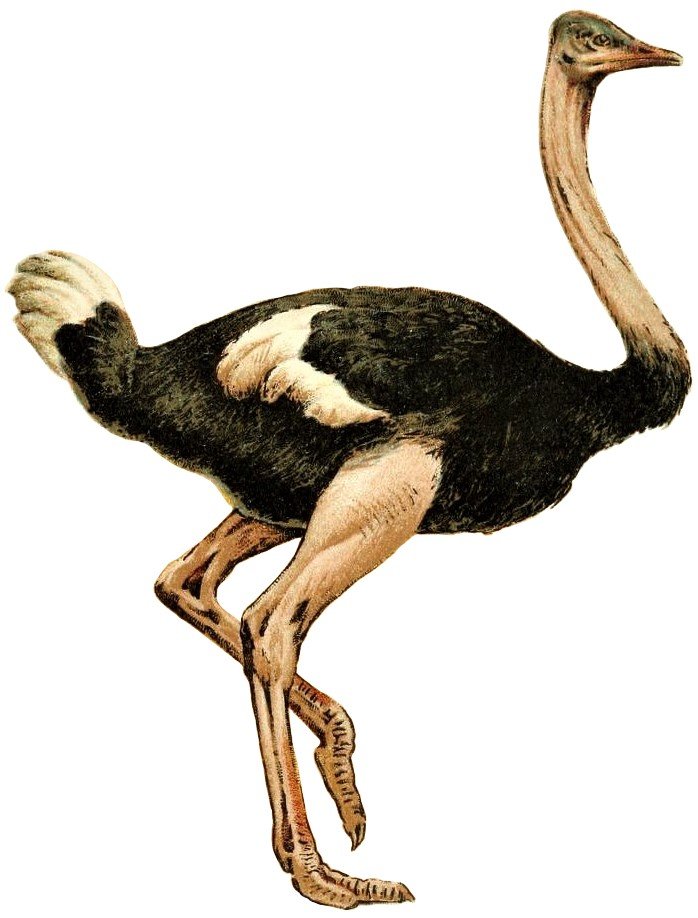
Pycraft, W. P., author, Book of Birds. Public domain. The Moa was driven into extinction, about 600 years ago on New Zealand. Cause: hunted out of existence and also change in habitat.
Most flightless birds have very strong legs and can run quickly. Most are very large, because their heavy bodies are not an impediment to flight, which would be the case in other bird species. Gigantism is characteristic of most flightless birds. An exception to this gigantism is the kiwi. Although the kiwi is the smallest of the Ratites, still, as birds go it is quite large. A kiwi weighs in at 4.5 to 8.5 pounds, and stands at 1.5 to 2 feet tall.
Kiwi, National Icon of New Zealand
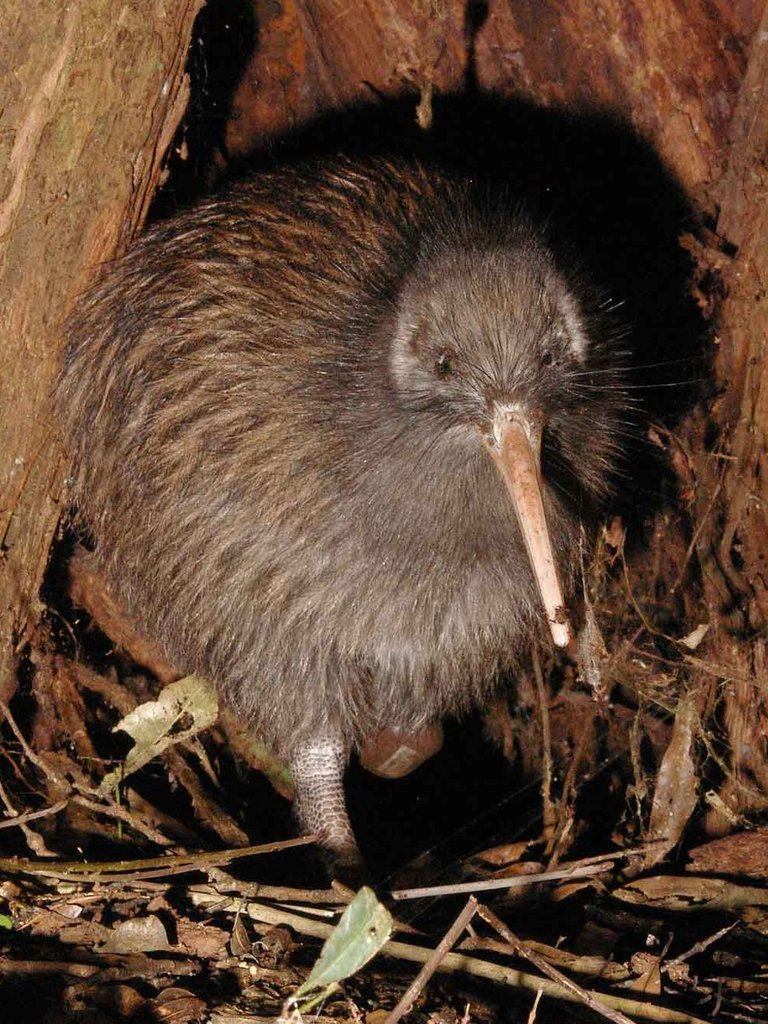
Maungatautari Ecological Island Trust. Public domain.
In the case of the emu, the strong legs and swift speed turned out to be great defenses against the human weaponry during the Great Emu War. The legs also serve as defenses against the emu's main predator, the dingo. The powerful kick of an emu can effectively fell a dingo.
One of the challenges facing Australian farmers in their struggle against the emu invasion was the emu's very successful breeding rate. It is estimated that 75% of emu chicks survive to adulthood. Contrast this with most bird species, in which only 30 to 40 percent survive.
Emu Father Guiding Chicks
Peterdownunder. Used under Creative Commons Attribution-Share Alike 4.0 International license..
The high survival rate of emu chicks may be due to the devoted care of the father. Emus in the wild are not monogamous. A female searches for an unpaired male and mates with him. Often there are fights between females over unpaired males.
This rivalry over unpaired males is not surprising. Once a female has laid her eggs (after about five months of remaining with a male), she takes off. The male incubates the eggs for about 8 to 10 weeks. He rarely leaves the nest and is said to often lose much of his body weight during this process because he fails to eat.
Youtube Video of Male Emu Brooding Eggs
When the chicks are growing, it is the male that shepherds them into adulthood. This takes approximately 18 months.
One vulnerability of flightless birds, including emus, is that they are mostly ground nesting. The emu nest is prepared by the male. He digs a little hollow in the ground and arranges twigs and leaves. The female lays her clutch (between five and fifteen eggs), and then leaves her male partner to do the rest. She may go off and mate with another male while he is occupied.
Although ground nesting would seem to make the emu young relatively vulnerable, the watchful care of the father helps to insure their safety.
**Youtube of Fiordland Crested Penguin, a Flightless Bird That Nests in Cliffs and Crevices and Underground
As mentioned earlier, the stage was set for the war by the Great Depression and a drought. Foraging emu destroyed struggling farmers' fragile crops. Farmers cried foul and insisted the government help to rid them of the 'vermin' (emus).
The Australian offensive force consisted of three men from the Royal Australian Artillery. The men were confident that their machine guns would make short work of the emu. Things didn't work out that way, though. It turned out, the emus were smarter than they looked.
Emu Eggs and Soldiers Resting by a Watering Hole: Picture Taken During the War
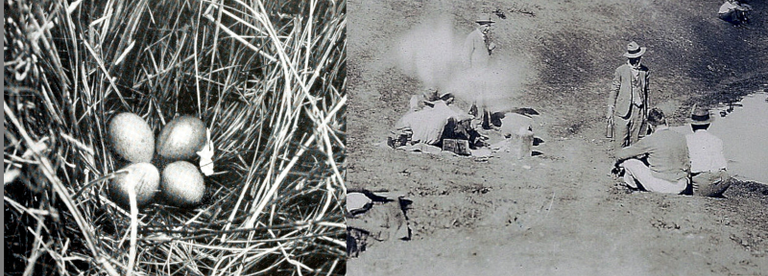
Credit: 子ファース. Used under public domain license.
One observer of the war suggested (tongue in cheek) that the emus were using guerilla tactics. They would send one large bird to their perimeter while the others foraged in the fields. When the humans appeared with guns, the lookout would alert the others and they would scatter. The animals ran so fast, and in such a disorganized way, that they made poor targets.
Smarter Than They Look?
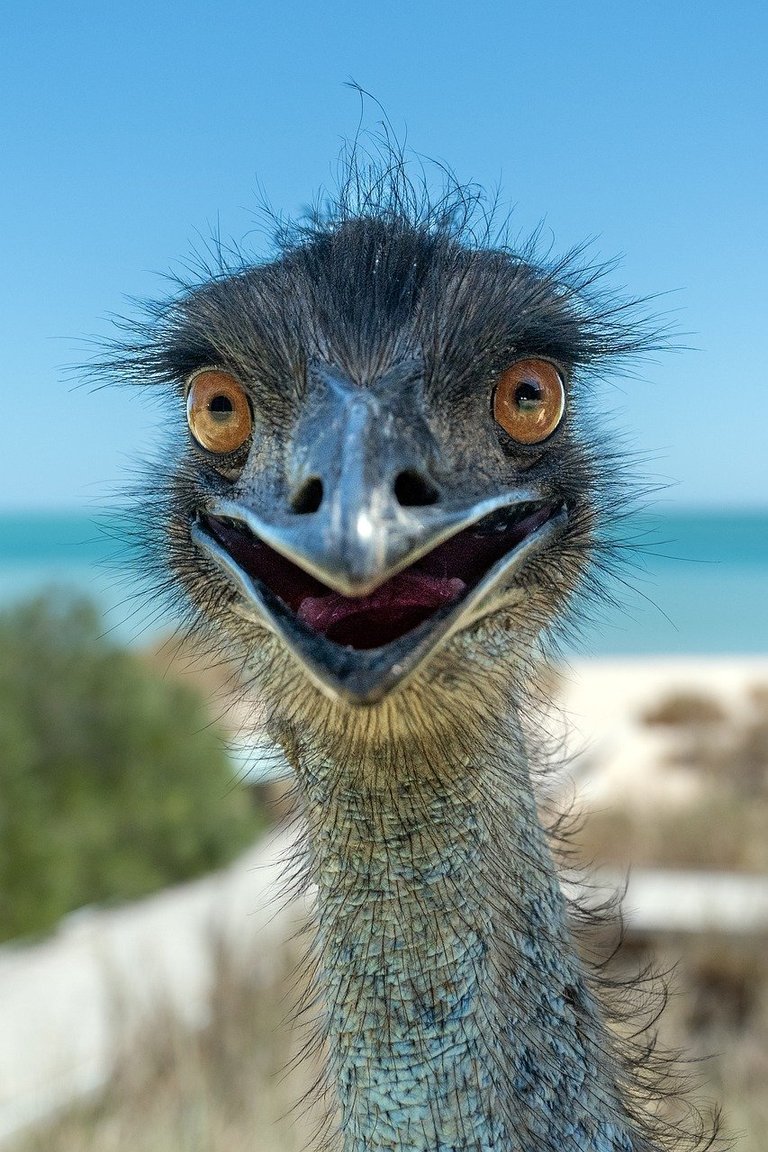
Credit: XiSerge on Pixabay
Even when they were hit, unless it was a great shot to the head, the emus' thick feathers seemed to deflect bullets. One soldier noted of the emus: They can face machine-guns with the invulnerability of tanks...
The war lasted from November to December of 1932. Many thousands of ammunition rounds were spent during the campaign. Estimates of the number of emus killed vary wildly, from 20 to hundreds, but the number was vastly disproportionate to the resources expended.
At the end of the war, the government faced ridicule and one newspaper concluded: No treaty of peace has been concluded, and the emus remain in possession of disputed territory.
Conclusion
The farmers in Australia did not give up their campaign against the emu. The government issued ammunition to individual farmers, and also offered a bounty on emus killed. Over 57,000 were killed over a six-month period. In the years that followed, hundreds of thousands were killed.
Today the emu enjoys protected status and the population is stable.
That's it. My account of the Great Emu War of 1932. Hope you were entertained.
To all my readers, be well, and peaceful.
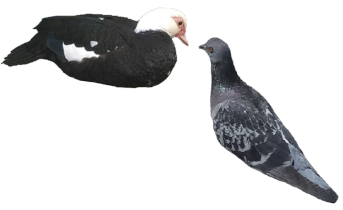
Credit: @yaziris and @muelli from the LIL Gallery
- End Illustration
@yaziris pigeon
https://www.lmac.gallery/lil-gallery-image/7643
@muelli bird
https://www.lmac.gallery/lil-gallery-image/8115
Research
https://www.toppr.com/ask/question/which-among-the-following-is-australias-national-bird/
https://nationalzoo.si.edu/animals/emu
http://bioweb.uwlax.edu/bio203/s2012/hawes_jenn/habitat.htm
https://australian.museum/learn/science/human-evolution/the-spread-of-people-to-australia/
https://www.sandboxx.us/news/this-is-the-story-of-the-australian-emu-war-of-man-vs-beast/
https://www.themeateater.com/conservation/wildlife-management/the-great-emu-war-of-1932
https://www.environment.nsw.gov.au/topics/animals-and-plants/native-animals/native-animal-facts/emu
https://historycollection.com/british-went-war-birds-lost-1932-emu-war/
https://www.toppr.com/ask/question/which-among-the-following-is-australias-national-bird/
https://www.technology.org/how-and-why/why-are-some-birds-better-off-when-being-unable-to-fly/
https://avibirds.com/large-flightless-birds/
https://royalsocietypublishing.org/doi/10.1098/rsos.170975
https://nationalzoo.si.edu/animals/north-island-brown-kiwi
https://www.doc.govt.nz/nature/native-animals/birds/birds-a-z/kiwi/
https://www.oaklandzoo.org/animals/emu
https://www.publish.csiro.au/ZO/ZO9950365
https://www.environment.nsw.gov.au/topics/animals-and-plants/native-animals/native-animal-facts/emu
https://www.abc.net.au/science/articles/2000/08/01/2689167.htm
https://birdfact.com/articles/emu-nesting
https://www.wildlife.vic.gov.au/__data/assets/pdf_file/0025/91384/Emu.pdf
https://www.britannica.com/topic/Emu-War
https://listverse.com/2017/03/12/10-crazy-facts-about-the-great-australian-emu-war/
Hive On!
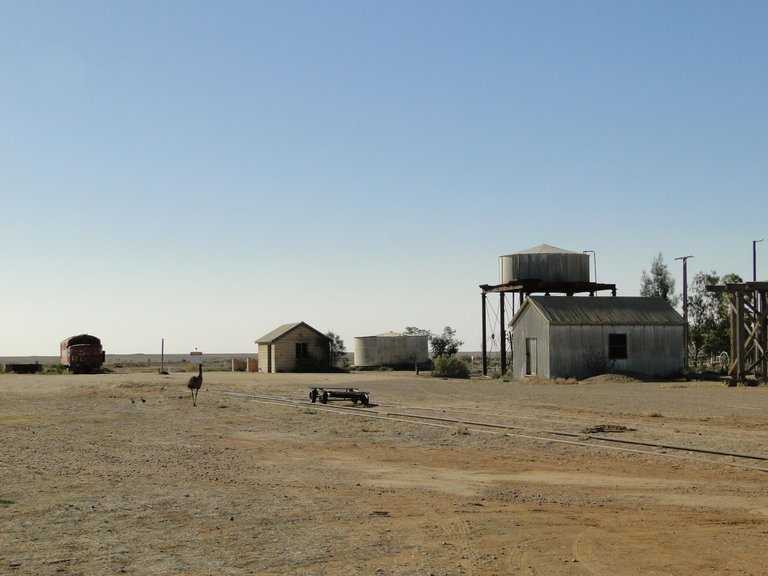
Heh, I remember reading about this years ago. Hilarious 😄😂
That's so funny. I almost referenced you in the blog, but then thought that might be intrusive. This reminded me of all those weird facts you come up with and write about. This fits right in.
It is hilarious 🌻🌟
This is a very well written write up about the emu and was an enjoyable read my dear friend.
I don't get the impression that it looks like a stupid bird, but rather a bird with a fast metabolic rate and aggressive survival instincts, which seems pretty accurate considering its defense was compared to tanks lol. I wouldn't even want to go near that thing.
On another note, the kiwi looks like it is half rodent, further suspicion being a "ratite". Maybe that's why it doesn't fly :D
Hello dear @futuremind,
Hope the New Year is treating you well, so far. First five days have been OK in my neck of the woods😇
This is was easy to write. There was so much information I had to decide what to leave out. For example, when the emus defended themselves there would be the one lookout that was sort of the sacrificial lamb. This emu would distract the humans and allow the others to get away. Often the humans were left with one mangled body (mangled by the tanks!), and nothing else. Such clever, socially positive behavior.
The humans' biggest mistake was in underestimating the emus.
And you're right--the kiwi does look part rodent. An amazing fact about kiwis (again, left out): They carry the largest eggs of all birds, proportionate to body size.
I'm glad you enjoyed the blog. When I first started on Hive I used to look for subjects that would interest others. Now I look for subjects that interest me first, and then that might appeal to others. Much more fun this way.
Have a wonderful week. Looking forward to seeing more pictures of your amazing plants this year.
Very informative post. Poor Emus.
By the way, Gondwana is that ancient, but its breakup started about 180 million years ago and birds probably appeared after that. This is just in case an unsuspecting reader thinks birds date back 420 million years. 😄
Thanks for stopping by and for the comment 😇
The picture of Gondwana is from 420 million years ago (or that's what they think, anyway). However, most sites I consulted say something like this:
I didn't intend to give a chronology for when birds, or flightless birds evolved. I didn't look that up (I look everything up because I am an interested reader, and reporter🙂) but not a scientist. The point I was making, was not when they evolved, but how they evolved. And even at that, aren't we just making educated guesses? Looking at evidence and drawing conclusions? As someone who is not expert, I rarely assert a scientific bit of information without sourcing it. That's not just because I am trying to be responsible about what I write. It's also because then I can point to the authority and leave myself blameless😄
I really appreciate the comment and the care with which you read the piece. It was fun writing this. I try not to write blogs unless the subject interests me and I'm having fun. Life is too short to be bored and unhappy.
Sure, it's just a small clarification.
Well, just to be clear, as you say, I added a little note under the picture of Gondwana. I credited you with the clarification. Why not be clear :))
Thanks for the note.
I already knew about the great Emu war of Australia.
Emu and Ostriches are quite deadly for birds, with the Emu being the most dangerous cause of their claws and their lack of shyness to peck at the head of disturbers.
Although they hardly go looking for trouble, known to attack only when one trespasses in their territory.
As always your posts are a delight to read, Happy New Year @agmoore senpai!!
Happy New Year, my young friend.
I just read about those emu claws, and the cassowary, also, apparently.
Heavens! Who knew?😁
Thanks for the great comment.
😂😂😂
Thanks for your contribution to the STEMsocial community. Feel free to join us on discord to get to know the rest of us!
Please consider delegating to the @stemsocial account (85% of the curation rewards are returned).
Thanks for including @stemsocial as a beneficiary, which gives you stronger support.
Thank you very much, @stemsocial. Happy New Year to everyone on the team.
Very informative as usual. These flightless birds always make me think of actual dinosaurs, as I think they might represent the closeset resemblance to what those "ancestors" actually used to look like.
Because... 😂
Be well my friend! 💚
😂
I love it!!
Thanks for the great comment, and for your continued encouragement. Means a lot
Be well and safe!! my friend @yaziris
What a fascinating bird with odd parenting habits. It's almost as if nature tries every possible combination when it comes to surviving and passing on the genetic information. Excellent and thorough article. 🐦
I know!! A culture dominated by females. I think that would drive you crazy😁
Thanks for commenting and for your support, as always.
Oh, I don't know about that. It might be kind of interesting being dominated by a group of females
have been in the know about war with starlings, rabbits... but not emu.
I stumbled on this. I was reading about flightless birds. Went through ostriches and kiwis. Then the emu came up and the Great Emu War. It was just too absurd to pass by.
Thanks for reading 🦅
Btw - are you in the know of the Herring Wars? there were several of them! no, this is not a struggle between man and herrings :) it was a struggle between UK and Iceland for the ocean territories where the herring was caught. A very interesting story! not that absurd, but... still.
Actually, it was a bit absurd...Never heard of it. Fascinating. England backs down three times!
It was actually quite a consequential war, not just for Britain and Iceland.
Thanks so much for the reference!
Wow, what an interesting read, this is the first time I will be hearing about the emus, whose feather could resist the attack of a gun, this is so rare. I am so happy I am now informed.
Thank you very much for that kind comment. I was also surprised by much of the information I learned when researching this blog.
Hope you have a wonderful 2024.
I didn't know anything about this bird before but after reading your post my knowledge has increased a lot and this bird is much more rare.
This is my first time learning about Emus and also some kinds of birds but do you have an idea if they still have Emus in Australia?
As I explain in the blog, they enjoy protected status in Australia today.
That was actually a big time of gun. So huge though